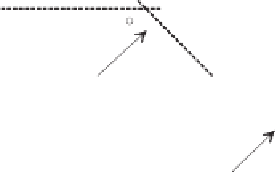Environmental Engineering Reference
In-Depth Information
100
AEV
=
60 kPa
90
80
0 kPa,
e
0.51
=
70
60
50
25 kPa,
e
=
0.514
40
30
(Optimum)
Initial water content
20
10
0
10
6
1
10
100
1000
10,000
100,000
Soil suction, kPa
(a)
250
(
s
f
-
u
a
)
f
=
72.6 kPa
200
f′ =
25.5
°
150
AEV
=
60 kPa
100
(
s
f
-
u
a
)
f
tan
f′
=
72.6 kPa
50
c
′
= 10 kPa
0
100
200
300
400
500
Matric suction (
u
a
-
u
w
), kPa
(b)
Figure 12.3
Curvature to shear strength envelope with respect to matric suction: (a) SWCC for
compacted glacial till (after Vanapalli et al., 1996a); (b) multistage direct shear strength tests on
compacted glacial till (from Gan et al., 1988).
Figures 12.6 and 12.7 show the relationship between
unconfined compression strength and total suction for the
silt soil and kaolin soil, respectively. There was a slight
increase in the shear strength at soil suctions beyond residual
conditions for both the silt and kaolin. The friction angle,
φ
(
drying
)
, beyond residual conditions for the silt soil and
kaolin were 0.02
◦
and 0.3
◦
, respectively. In other words, the
failure envelope with respect to soil suction is essentially
horizontal in the total suction range beyond residual suction.
When soil suctions were decreased from 124,000 to
94,000 kPa (i.e., a wetting process), there was a reduction in
shear strength for both the silt soil and kaolin. A decrease in
shear strength was measured with decreasing soil suction,
and the failure envelope during wetting is shown in Figs. 12.6
and 12.7. The friction angle,
φ
(wetting)
, with respect to the
wetting portion were 0.01
◦
and 0.05
◦
for the silt soil and
kaolin, respectively. Once again, the failure envelope angles
were essentially 0
◦
in the region beyond residual suction.
There were slight differences in strength measured for the
drying and wetting portions of the shear strength envelope;
however, in both cases the overall angles of shearing
resistance were close to 0
◦
.
Further shear strength test data from the suction range
beyond residual suction would be useful; however, it is
usually the changes in shear strength in the suction range
below residual suction that are of greatest interest in engi-
neering practice. In general, it would appear to be reasonable
to assume that the
φ
b
angle is 0
◦
beyond residual suction
conditions. The primary exception would be sand soils where
the
φ
b
angle might decrease with increasing suction (i.e.,
become a negative value).
12.2.2 Categorization of Shear Strength Equations
for Unsaturated Soils
Numerous equations have been proposed for describing the
shear strength of unsaturated soils. Figure 12.8 subdivides
shear strength equations for unsaturated soils into those that
can be used to “best fit” a data set and those that can be
used to estimate the unsaturated soil shear strength function
based on the SWCC for a soil as well as other soil properties.
The theory and measurement of unsaturated shear strength
properties were presented in Chapter 11. This chapter pri-
marily focuses on the estimation of the shear strength of an






























Search WWH ::

Custom Search